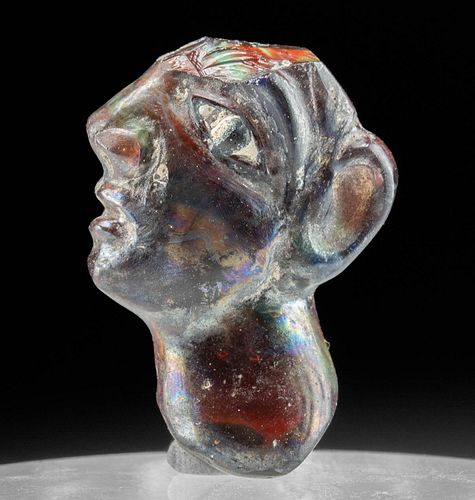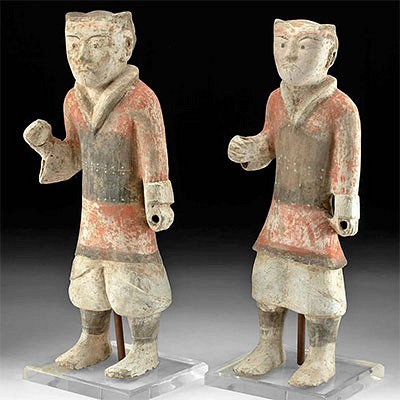Egyptian Sebennytic-Ptolemaic Glass Inlay
Lot 2b
About Seller
Artemis Fine Arts
686 S Taylor Ave, Ste 106
Louisville, CO 80027
United States
Selling antiquities, ancient and ethnographic art online since 1993, Artemis Gallery specializes in Classical Antiquities (Egyptian, Greek, Roman, Near Eastern), Asian, Pre-Columbian, African / Tribal / Oceanographic art. Our extensive inventory includes pottery, stone, metal, wood, glass and textil...Read more
Categories
Estimate:
$1,800 - $2,700
Absentee vs Live bid
Two ways to bid:
- Leave a max absentee bid and the platform will bid on your behalf up to your maximum bid during the live auction.
- Bid live during the auction and your bids will be submitted real-time to the auctioneer.
Bid Increments
| Price | Bid Increment |
|---|---|
| $0 | $25 |
| $300 | $50 |
| $1,000 | $100 |
| $2,000 | $250 |
| $5,000 | $500 |
| $10,000 | $1,000 |
| $20,000 | $2,500 |
| $50,000 | $5,000 |
| $100,000 | $10,000 |
| $200,000 | $20,000 |
About Auction
By Artemis Fine Arts
May 25, 2023
Set Reminder
2023-05-25 10:00:00
2023-05-25 10:00:00
America/New_York
Bidsquare
Bidsquare : ON-SALE! Antiquities, Pre-Columbian, Ethno, Fine Art
https://www.bidsquare.com/auctions/artemis-gallery/on-sale-antiquities-pre-columbian-ethno-fine-art-12860
ON-SALE Antiquities, Pre-Columbian, Ethno, More! Artemis Fine Arts info@artemisgallery.com
ON-SALE Antiquities, Pre-Columbian, Ethno, More! Artemis Fine Arts info@artemisgallery.com
- Lot Description
Egypt, perhaps the city of Sebennytos, Late Dynastic (30th Dynasty) to Ptolemaic Period, Sebennytic-Ptolemaic Period, ca. 380 to 30 BCE. A delicate, mold-formed glass inlay used to create a stunning figural decoration. The translucency of the glass displays slender streaks of vermilion and chartreuse when placed next to a light source and allude to the skill of the craftsman. With an upward gaze the visage stares, the inlaid eye of black and white paste glass peering out through the sands of time as gentle grooves illustrate the sizable nostril and pursed lips. Behind the sweeping black eyebrow is a recessed, ovoid ear, perhaps used to support the back of a larger headdress inlay, and below is a thick neck that was perhaps covered by the pectoral collar of a larger glass body inlay. The visage has a rounded base that would have fit into a larger composite figural inlay as it perhaps represents a pharaoh that was meant to receive a separate glass headdress. Size: 0.88" W x 1.2" H (2.2 cm x 3 cm)
The Thirtieth Dynasty is characterized by a myriad of scholars as being one of the last great periods of ancient Egyptian dynastic rule. The seat of the pharaoh in the Thirtieth Dynasty was situated in the Lower Egyptian city of Sebennytos located on the Damietta (Sebennytic) branch of the Nile Delta. According to authors E. Marianne Stern and Birgit Schlick-Nolte, "Egyptian art reached its last peak under the Thirtieth Dynasty. Well aware of the power of images, Ptolemy adopted Egyptian art forms and Egyptian ceremony to justify his rule in the eyes of the Egyptian people. The traditional Egyptian art forms continued from the Thirtieth Dynasty into the third century B.C., providing the name Sebennytic-Ptolemaic for the art of this period. Subsequently, the influence of Greek style elements significantly increased. Several stylistic features of [profile inlays] are characteristic of the Sebennytic-Ptolemaic style: the receding eyebrow, prominent mouth with pursed lips, golf-ball chin, and long neck with a curving edge." (Stern, E. Marianne and Birgit Schlick-Nolte. "Early Glass of the Ancient World: 1600 B.C. - A.D. 50 | Ernesto Wolf Collection." Verlag Gerd Hatje, Germany, 1994, p. 340)
PLEASE NOTE: Due to recent increases of shipments being seized by Australian & German customs (even for items with pre-UNESCO provenance), we will no longer ship most antiquities and ancient Chinese art to Australia & Germany. For categories of items that are acceptable to ship to Australia or Germany, please contact us directly or work with your local customs brokerage firm.
Provenance: East Coast collection, New York Gallery, New York City, New York, USA, acquired before 2010
All items legal to buy/sell under U.S. Statute covering cultural patrimony Code 2600, CHAPTER 14, and are guaranteed to be as described or your money back.
A Certificate of Authenticity will accompany all winning bids.
We ship worldwide and handle all shipping in-house for your convenience.
#175432Chips and abrasions to most surfaces, with light pitting on paste glass eye, otherwise in great condition. Wonderful glass coloration visible when placed next to a light source.Condition
- Shipping Info
-
All shipping is handled in-house for your convenience. Your invoice from Artemis Gallery will include shipping calculation instructions. If in doubt, please inquire BEFORE bidding for estimated shipping costs for individual items.
-
- Buyer's Premium



 EUR
EUR CAD
CAD AUD
AUD GBP
GBP MXN
MXN HKD
HKD CNY
CNY MYR
MYR SEK
SEK SGD
SGD CHF
CHF THB
THB













